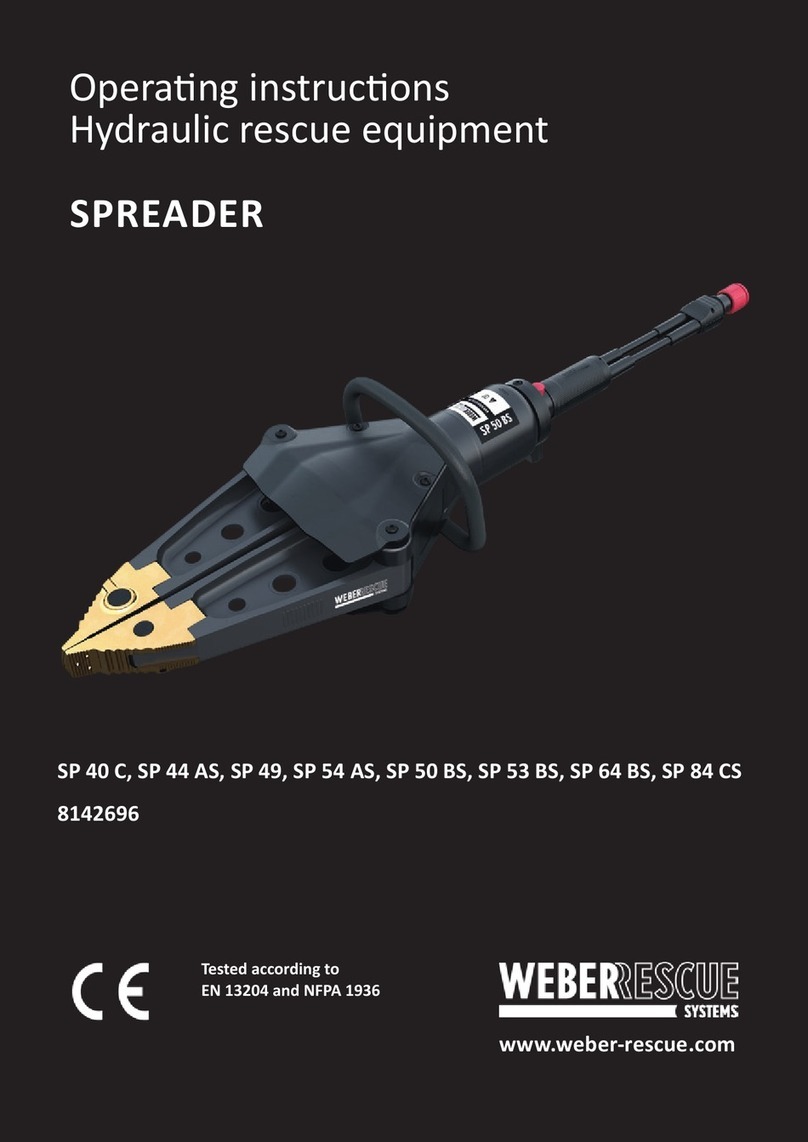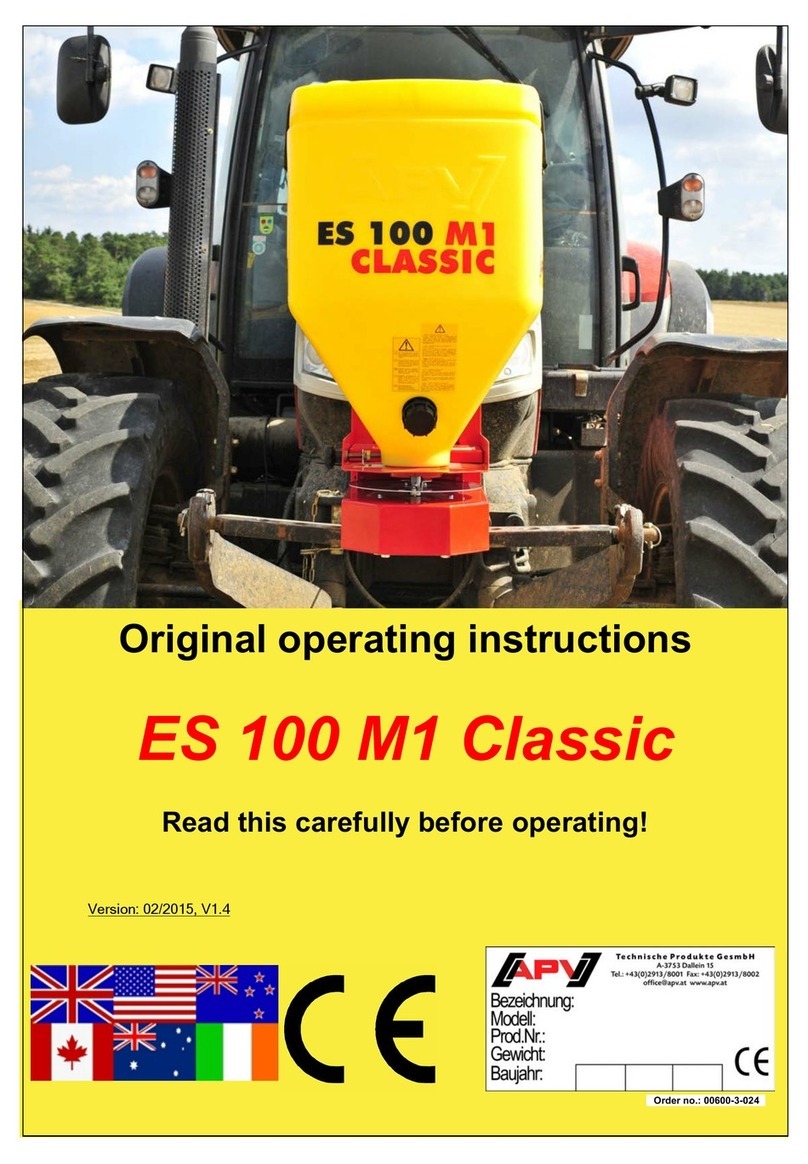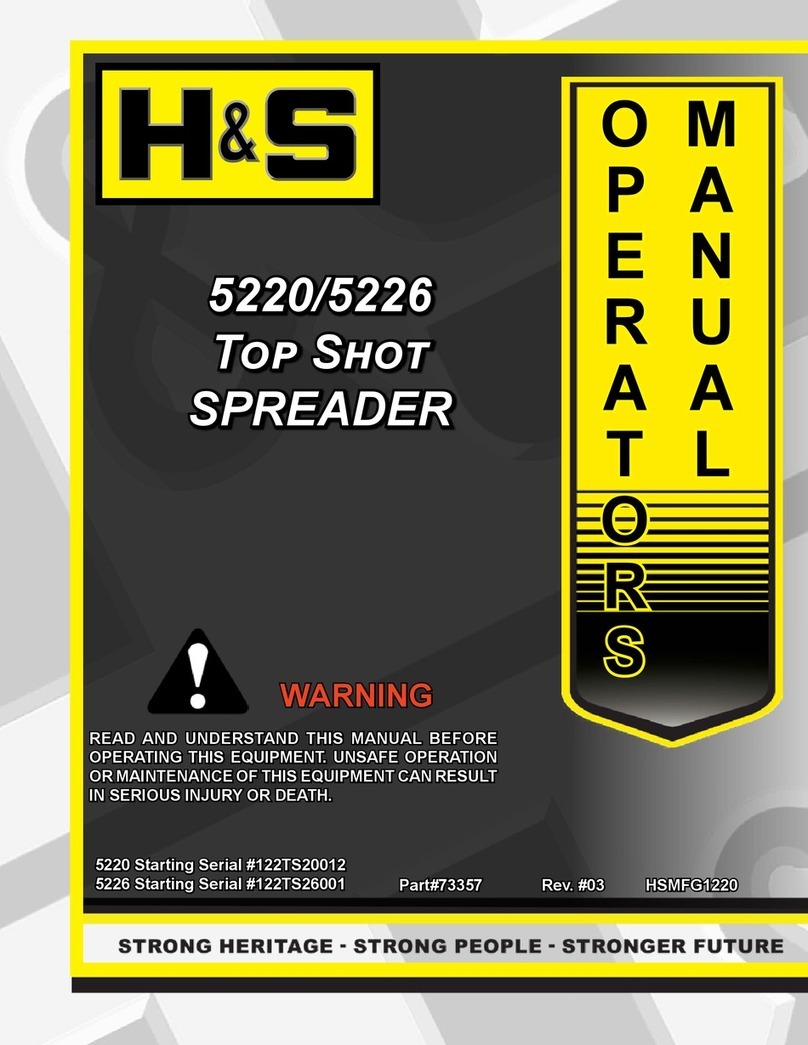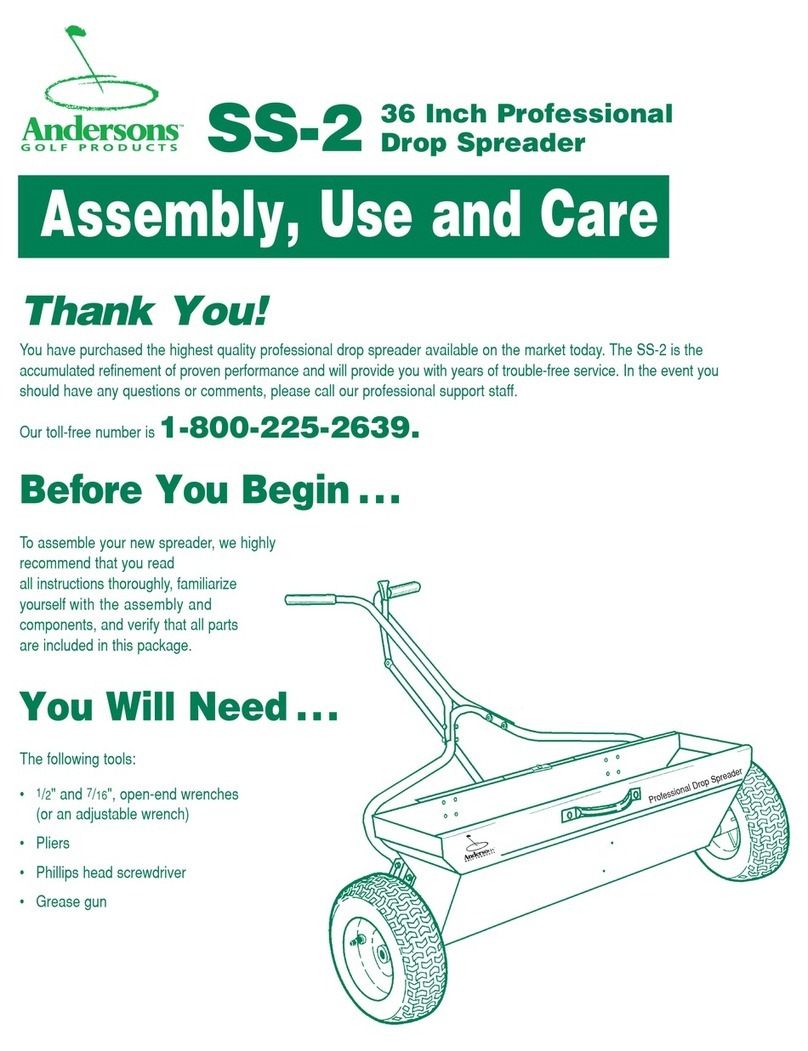Weber Rescue Systems SP 35 AS User manual

Operang instrucons
Hydraulic rescue equipment
SPREADER
Tested according to
EN 13204 and NFPA 1936
SP 35 AS, SP 43 XL, SP 49, SP 53 BS, SP 60, SP 80
8142696
www.weber-rescue.com

2 | Table of Contents
Table of Contents
1 Generalinformaon 4
1.1 About the operang manual 4
1.2 Explanaon of symbols 5
1.3 Limitaons of liability 6
1.4 Copyright 6
1.5 Warranty condions 7
1.6 Customer service 7
2 Safety 8
2.1 Intended use 8
2.2 Responsibility of the customer 9
2.3 Operang personnel 10
2.4 Personal protecve equipment 11
2.5 Specic hazards 12
2.6 Safety devices 14
2.7 How to respond in the event of danger or accidents 15
2.8 Signage 16
3 Technical data 17
3.1 Spreader 17
3.2 Operang condions 18
3.3 Type plate 18
4 Structureandfuncon 19
4.1 Overview 19
4.2 Brief descripon 19
4.3 Hydraulic supply 20
4.4 Equipment connecons 22
4.5 Use of the control handle 24
4.6 Changing the spreader ps 25

Table of Contents | 3
5 Possibleapplicaons 26
5.1 Safety informaon 26
5.2 Spreading 26
5.3 Pulling 27
5.4 Crushing 28
5.5 Liing 29
5.6 Peeling 29
6 Transport, packaging and storage 30
6.1 Safety informaon 30
6.2 Transport inspecon 30
6.3 Symbols on the packaging 31
6.4 Disposal of packaging 31
6.5 Storage 31
7 Installaonandcommissioning 32
7.1 Safety informaon 32
7.2 Checking 33
7.3 Installaon 33
7.4 Shung down (end of work) 34
8 Service 35
8.1 Safety informaon 35
8.2 Care and maintenance 35
8.3 Maintenance schedule 36
9 Malfuncons 37
10 Decommissioning / recycling 38
11 ECDeclaraonofConformity 39

1Generalinformaon
1.1 About the operang manual
This operang manual provides important informaon on using spreader devices. Proper
compliance with all specied safety instrucons and guidelines is a prerequisite for safe work.
Furthermore, adhere to the local accident prevenon guidelines and general safety regulaons
for the region in which the devices are used.
These operang instrucons must be carefully read prior to starng any work! They are an
inherent part of the product and must be kept in a place that is known and accessible to
personnel at all mes.
This documentaon contains informaon for operang your equipment. However,
you may also nd informaon which may not directly apply to your specic equipment.
All informaon, technical data, graphics and diagrams contained in these operang instrucons
are based on the latest data available at the me of the document's creaon.
We recommend that, in addion to carefully reading through the operang manual, you be
trained on handling the rescue equipment (possible applicaons, applicaon taccs, etc.) by
our qualied trainers.
4|Generalinformaon

Generalinformaon|5
1.2 Explanaon of symbols
Warnings
Warnings are marked by symbols in this operang manual.
The individual instrucons are introduced by signal words that express the severity of the
hazard.
It is essenal to comply with the instrucons in order to prevent accidents, injuries and damage
to property.
DANGER!
… indicates an imminently dangerous situaon that can result
in death or serious injury if not avoided.
WARNING!
… indicates a potenally dangerous situaon that can result in
death or serious injury if not avoided.
CAUTION!
… indicates a potenally dangerous situaon that can result in
minor or light injuries if not avoided.
ATTENTION!
… indicates a potenally dangerous situaon that can result in
material damage if not avoided.

6|Generalinformaon
Tipsandrecommendaons
NOTE!
... highlights useful ps and recommendaons, as well as i
nformaon for ecient, trouble-free operaon.
1.3 Limitaons of liability
All informaon and instrucons in this operang manual have been compiled in keeping with
applicable standards and guidelines, the current state of technology, and our many years of
knowledge and experience.
The manufacturer assumes no liability for damage due to:
• Failure to comply with the operang manual
• Unintended use
• Assignment of untrained personnel
• Unauthorised modicaons
• Technical changes
• Use of non-approved replacement parts
• Use of non-original replacement parts
The actual scope of delivery can vary from the explanaons and graphic representaons
provided in this manual in the case of special versions, or due to technical changes.
1.4 Copyright
All texts, diagrams, drawings and images in this operang manual may be used without
restricon and without any prior approval.

Generalinformaon | 7
NOTE!
Further informaon, images and drawings can be found on our
website www.weber-rescue.com
1.5 Warranty condions
The warranty condions can be found as a separate document in the sales documentaon.
1.6 Customer service
Our customer service is available to you for technical informaon.
Germany
Name: Ms. Corina Schulz
Telephone: + 49 (0) 7135 / 71-10235
Fax: + 49 (0) 7135 / 71-10396
E-Mail: corina.schulz@weber-rescue.com
Austria
Name: Mr. Robert Hack
Telephone: + 43 (0) 7255 / 6237-12473
Fax: + 43 (0) 7255 / 6227-12461
E-Mail: robert.hack@weber-rescue.com
NOTE!
When contacng our customer service department please state
your equipment's designaon, type and producon year.
These details can be found on the equipment type plate.

8 | Safety
2 Safety
This secon of the operang manual provides a comprehensive overview of all the important
safety aspects for opmal protecon of operang personnel, as well as for safe and trouble-free
operaon.
Signicant hazards can occur if the handling and safety instrucons in this manual are not
complied with.
2.1 Intended use
The hydraulic spreaders are designed and tested exclusively for the appropriate designated
purposes described here. All other activities are fundamentally prohibited.
Spreaders (SP 35 AS, SP 43 XL, SP 49, SP 53 BS, SP 60, SP 80)
• All of the spreaders are designed as one-man devices and may therefore
be operated by one person only.
• The devices serve exclusively for the opening of doors, the lifting of
vehicles or other moveable loads, the pushing away and moving of
vehicle parts and loads and the crushing of tubes and pillars.
• The spreader ps should be used whenever possible for crushing.
• The spreader ps can be used as a peeling tool.
• The chain set is to be used exclusively for pulling.
WARNING!
Improper use can be dangerous!
Any improper or unintended use of the devices can be hazardous!
Therefore, make absolutely sure that:
»The devices are used only for the applicaons stated above.
»All other informaon on proper use of the devices in Chapter 5
(Possible applicaons) is observed.

Safety | 9
2.2 Responsibility of the customer
In addion to the health and safety instrucons in this operang manual, one must adhere to
the safety, accident prevenon, and environmental protecon guidelines for the region in which
the equipment is used. Parcularly applicable in this regard:
• The customer must be familiar with the applicable health and safety
provisions and in a hazard analysis idenfy other hazards that may
exist at the equipment‘s installaon site due to the special working
condions.
• The customer must clearly regulate and specify responsibilies
for installaon, operaon, maintenance and cleaning.
• The customer must ensure that all personnel who handle the equipment
have fully read and understood the operang manual.
• In addion, at regular intervals, the operator must train personnel and
inform them of the hazards of working with the equipment.
Moreover, the customer is responsible for ensuring that the equipment is always in technically
faultless condion. Consequently, the following applies:
• Aer each use, and at least once a year, a visual inspecon of the
equipment must be carried out by a trained individual (according to
DGUV Grundsatz 305-002 or country-specic guidelines).
• Every three years, or if you have doubts about the safety or reliability
of the equipment, funconal tesng and stress tesng must be carried out
(according to DGUV Grundsatz 305-002 or country-specic guidelines).

10 | Safety
2.3 Operang personnel
The following qualicaons are cited in the operang instrucons for the various acvity areas:
• Trained individual
is informed through training oered by the customer about the tasks
assigned to him and the possible dangers of improper conduct.
• Specialist
is someone who, due to specialised training, skills and experience, as
well as knowledge of the applicable spulaons by the manufacturer, is
capable of execung the tasks assigned to him or her and of
independently recognising possible hazards.
WARNING!
Inadequate training can result in injuries!
Improper handling of the equipment can lead to serious
injury or material damage.
Therefore, make absolutely sure to:
»allow parcular tasks to be carried out only by the persons
stated in the relevant chapter of this manual.
»When in doubt, call in specialists immediately.
NOTE!
The equipment may not be used by personnel who have
consumed alcohol, medicaon or drugs!
This manual suits for next models
5
Table of contents
Other Weber Rescue Systems Spreader manuals
Popular Spreader manuals by other brands

Fisher
Fisher POLY-CASTER 78601 owner's manual

Fayat Group
Fayat Group DYNAPAC S100 operation & maintenance

Art's-Way Manufacturing
Art's-Way Manufacturing X700 Operator's manual & parts list

Ferris
Ferris Pathfinder Series Operator's manual

Herculano
Herculano H2RS9 instruction manual

TurfEx
TurfEx RS7200 Owner's/operator's manual












